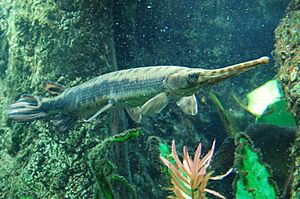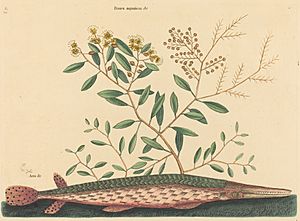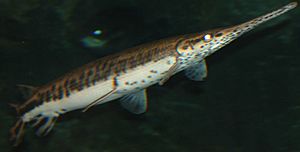Longnose gar facts for kids
Quick facts for kids Longnose gar |
|
|---|---|
 |
|
| At the New England Aquarium | |
| Conservation status | |
| Scientific classification |
The longnose gar (Lepisosteus osseus) is a unique fish found in North and Central America. It's also called the longnose garpike or billy gar. This fish belongs to a very old family of ray-finned fish called Lepisosteidae.
Longnose gars have been around for about 100 million years! They are sometimes called "primitive" fish because they have kept some features from their ancient ancestors. However, they are actually very well-developed and have changed a lot over millions of years.
These fish have a long, torpedo-shaped body. It's covered in tough, bony scales that act like armor. Their most noticeable feature is their long, needle-like snout, which is almost three times longer than their head. This snout is filled with many sharp, cone-shaped teeth.
Longnose gars live in freshwater lakes, swamps, and slow-moving rivers. They can also be found in slightly salty water near coasts. A cool fact about them is that they can breathe both air and water. This helps them survive in places where there isn't much oxygen in the water.
Contents
What is a Longnose Gar?
Longnose gars are found along the eastern coast of North and Central America. In the United States, they live as far west as Kansas, Texas, and southern New Mexico. The longnose gar is the only type of gar found in New Mexico.
Their populations are healthy and even abundant in many parts of their range. This means there are lots of them!
Naming the Longnose Gar
The longnose gar was first described by a famous scientist named Carl Linnaeus in 1758. He first named it Esox osseus. Esox is the name for pike fish. Later, its name was changed to Lepisosteus, which is the genus for slender gars.
The scientific name, Lepisosteus osseus, comes from two words. Lepis is a Greek word meaning "scale." Osteos is a Latin word meaning "bony." This name refers to their strong, bone-like scales that protect them.
Gars are sometimes called "living fossils." This is because they still have some features from their very old ancestors. For example, they have a special intestine and a swim bladder that works like a lung. This allows them to breathe air when needed. Calling them "primitive" just means they have existed for a very long time. They have changed and improved over millions of years.
Where Do Longnose Gars Live?
Scientists have found fossils of gar fish that are 100 million years old! These fossils have been found in places like Africa, Asia, Europe, North America, and South America. In the U.S., fossils of the modern longnose gar have been found in Kansas.
Today, longnose gars live in Central America, Cuba, and North America. They are often found in freshwater in the eastern half of the United States. However, some have been found in water that is quite salty.
They like to live in areas with downed trees, rocks, and lots of plants. These spots offer good hiding places and hunting grounds.
What Do Longnose Gars Eat?
Longnose gars mainly eat small fish. Sometimes they also eat insects and small crustaceans (like shrimp). They usually hunt and feed at night.
What they eat can change depending on where they live. For example, in Lake Texoma, young gars mostly ate Inland silversides. In Florida, their diet included gizzard shad, bullhead catfish, and small bluegill. In Missouri, they mostly ate shiners.
Along the coast, longnose gars might move into saltier waters to find fish like Menhaden. Then, they move back to less salty waters in the morning. Other gars are their main competitors for food. Sometimes, larger gars even eat smaller ones!
Who Eats Longnose Gars?
Historically, Native Americans and early settlers used to eat longnose gars. Today, they are more popular as a sportfish. However, some people still enjoy eating gar meat.
Adult longnose gars are at the top of the food chain in their habitats. They have very few predators. Humans are one predator. In the southern parts of their range, American alligators also hunt them.
Young gars are much more vulnerable. They can be eaten by other gars, larger fish, birds, snapping turtles, and water snakes.
Life Cycle and Reproduction
Longnose gars can live for a long time, usually 15 to 20 years. The oldest one ever found was 39 years old! This long lifespan helps females mature and reproduce.
Female gars usually become ready to have babies around six years old. Males mature much earlier, sometimes as young as two years old. Female gars are generally larger than males in length, weight, and fin size.
A female gar can lay around 30,000 eggs at once! Larger females lay more eggs. They usually spawn (lay eggs) when the water temperature is around 20°C, from late April to early July.
Their eggs have a sticky, toxic coating. This helps the eggs stick to rocks, plants, or even in smallmouth bass nests. The eggs hatch in about 7 to 9 days. Young gars stay hidden in plants during their first summer.
Longnose gars typically grow to be about 28 to 48 inches (0.7 to 1.2 meters) long. Some can grow much larger, up to 6 feet (1.8 meters) long and weigh 55 pounds (25 kg)!
Conservation and Management
Currently, there aren't many specific programs to manage longnose gar populations. They are not listed as endangered by the federal government. However, some states, like South Dakota, Delaware, and Pennsylvania, consider them threatened.
In the early 1900s, people thought longnose gars were harmful predators. Because of this, efforts were made to reduce their numbers. Today, their populations are declining in some areas due to several reasons:
- Overfishing: Too many fish are caught.
- Habitat destruction: Their homes are being destroyed.
- Dams and road construction: These can block their movements and change their habitats.
- Pollution: Dirty water harms them.
- Other human activities that damage aquatic systems.
Because female gars take a long time to mature (around six years), overfishing is a big problem. If too many young fish are caught before they can reproduce, it can hurt the population.
Images for kids
See also
 In Spanish: Pejelagarto narigudo para niños
In Spanish: Pejelagarto narigudo para niños











